If you’re choosing an AI app generator this year, pick the one that gets you to a working, ownable codebase at the lowest cognitive load; everything else is noise.
Questions you’re probably asking:
- Which AI builders create usable full-stack apps (not just pretty UIs)?
- Where do they top out: prototype (L3), full-stack CRUD (L4), or production-grade SaaS (L5)?
- Do I truly own/export the code, and how painful is deployment?
- What traps should I expect: context loss, hidden costs, security, lock-in?
In our 2025 study (303 respondents, 33 countries), 38% now start with AI app generators; manual-only coding fell to 20.8%. Real outcomes are no longer hypothetical: 31.7% report reaching L3 (frontend + external backend), 29.4% reach L4 (custom full-stack with CRUD/auth/db), and 14.5% claim L5 production-grade builds. Friction remains: context loss (45.5%), pricing opacity (41.9%), security/reliability (35%), and limited customization (33.3%), yet 11.2% reported no major issues. See prior years for trendlines: 2022, 2023, 2024.
We’ve conducted this research for four consecutive years and built AI-assisted production apps for clients using the Flatlogic Generator (Node.js + Next.js + Tailwind, GitHub, Cloud Run). You’ll find real-world cases across SaaS and internal systems. We also disclose where Flatlogic shines and where others do.
What you’ll get by the end.
- Crisp definitions (vibe-coding, L1–L5 outcomes, code ownership).
- A no-BS comparison of 8+ web app AI generators.
- Who is each tool best for / not ideal for, with L-level sweet spots?
- A pragmatic pick-path depending on your stack, team, and risk tolerance.

Terminology / Definitions
To help you navigate this analysis effectively, we’ve expanded key terminology and concepts clearly and comprehensively:
- AI-Powered App Generator– software platforms leveraging artificial intelligence (AI) to automatically generate web application code from plain English descriptions. These tools accelerate development, significantly reducing manual coding effort and enabling rapid deployment of functional applications.
- Vibe-coding – a conversational software-building approach where developers iteratively communicate with AI. You describe your app’s features and logic in natural language, and AI scaffolds the code, refining it collaboratively through chat-based interactions or specialized IDEs.
- Outcome Levels (self-reported in our study):
To benchmark and categorize the complexity and completeness of web apps produced with AI-powered generators, we established five clearly defined outcome levels:
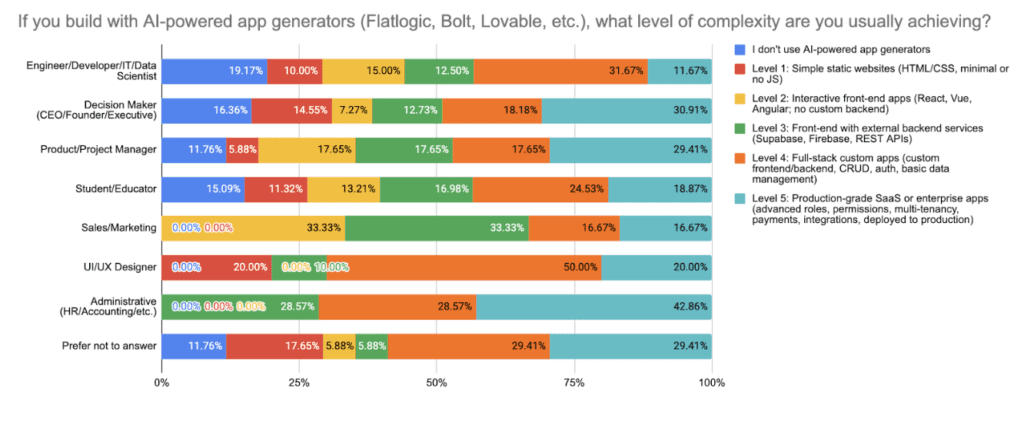
- Level 1 (L1): Static Website – Basic websites with static content (HTML/CSS), minimal JavaScript interactions.
- Level 2 (L2): Interactive Frontend Applications (no backend) – Interactive frontends built with frameworks like React or Vue, without backend integration.
- Level 3 (L3): Frontend Integrated with External Backend – Frontends integrated with external backend services (Firebase, Supabase, APIs), supporting user authentication and data storage.
- Level 4 (L4): Custom Full-stack Application – Custom-built full-stack apps with backend logic, CRUD operations, database management, and secure authentication.
- Level 5 (L5): Production-grade SaaS / Enterprise Applications – Fully featured, enterprise-grade apps with multi-tenancy, advanced role-based permissions, secure payments, comprehensive logging, and robust deployment capabilities.
AI-Powered App Generators in 2025: Industry Landscape and Trends
The landscape for AI-powered web app generators has matured dramatically by 2025, marking a significant turning point in software development practices:
- Mainstream Adoption:
AI-driven web app generation has swiftly transitioned from experimental to essential, becoming a primary method for starting new web applications. Our research indicates 38% of respondents now utilize AI-powered tools as their default method for app creation, surpassing traditional manual coding (20.8%) and low-code/no-code tools (6.3%). - Shift in Complexity Levels:
AI app generators no longer produce merely simplistic scaffolds. A significant share of users now regularly achieve advanced complexity levels: 31.7% develop frontend apps integrated with backend services (Level 3), nearly 30% produce full-stack custom applications with CRUD logic (Level 4), and 14.5% successfully reach production-grade SaaS with sophisticated features like multi-tenancy and role-based access (Level 5). - Emergence of Vibe-Coding:
Conversational or iterative development, known as “vibe-coding,” has rapidly gained traction. This method allows users to interactively build applications through conversational prompts, iterating on results with AI assistance, effectively making development more intuitive and collaborative. - Persistent User Concerns:
Despite its broad adoption, users frequently report several common challenges associated with AI app generation tools. The most notable concerns include architectural context loss (45.5%), unclear or hidden pricing structures (41.9%), security and reliability risks (35%), and limited customization capabilities (33.3%). Yet, a growing minority (11.2%) reports experiencing no significant issues, indicating increasing tool maturity. - Preference for Code Ownership and Flexible Deployment:
Users increasingly demand full code ownership, easy exportability, and flexibility in deployment. The industry now favors tools that offer clear pathways to cloud platforms like AWS, Google Cloud, and Vercel, as well as tools that produce clean, maintainable, and fully ownable repositories for ongoing development and scalability.
In essence, the year 2025 marks the maturation and consolidation phase of AI-powered web application generation, signaling its firm establishment as a central pillar in the software development landscape.
Top 8+ AI-Powered App Generators of 2025
Below you’ll find a detailed, alphabetical list (to avoid popularity bias) of the most impactful AI-powered app generators, each offering distinct strengths. Our analysis leverages comprehensive research involving 303 participants across 33 countries, highlighting realistic outcome levels achieved by actual users.
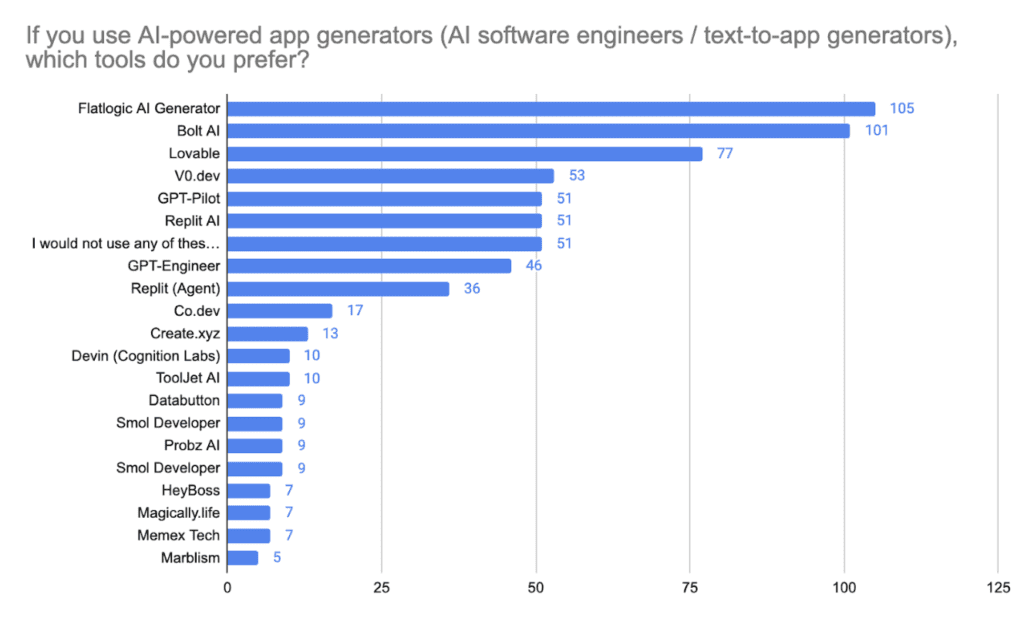
Bolt.new (by Vercel)
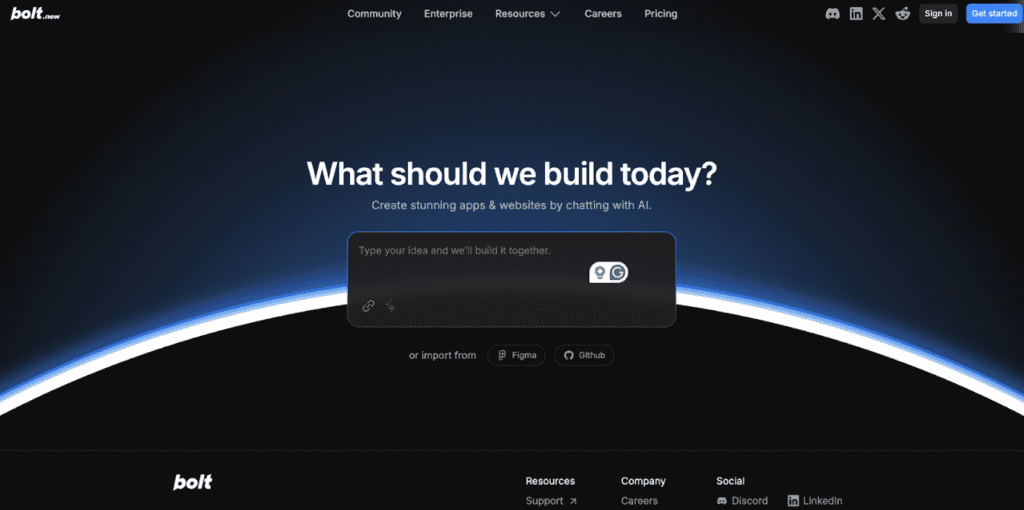
Bolt.new rapidly creates modern web applications through conversational prompts, making it ideal for teams needing a quick start. Integrated deeply with Vercel’s ecosystem, it streamlines front-end development and server-side logic with minimal friction.
- What it generates:
Full-stack web applications, including frontend views, server routes, database access, and essential logic, enabling you to rapidly prototype and iterate your apps. - Outcome sweet spot:
Reliable at achieving Level 3 (frontend apps integrated with backend services). Level 4 is achievable, but usually requires manual adjustments for full CRUD and complex logic. Level 5 (production SaaS) can be reached with dedicated enhancements. - Code ownership/export:
Clean code export directly into GitHub repositories, fully customizable, with complete code ownership retained by users. - Strengths:
Exceptional speed and ease-of-use for prototypes; smooth user experience; tight integration within the Vercel ecosystem for hassle-free deployments. - Best for:
Teams rapidly iterating on MVPs, frontend developers seeking quick app launches, or startups needing frequent updates.
Create.xyz
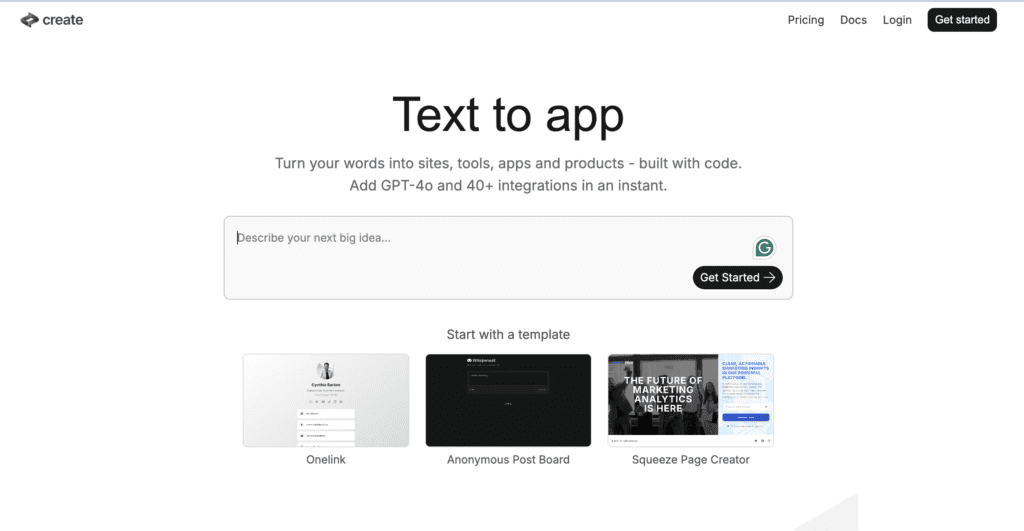
Create.xyz offers an AI-driven approach designed specifically for quickly turning natural language descriptions into interactive, visually compelling web apps. It emphasizes streamlined collaboration, making it especially useful for teams looking to rapidly iterate on ideas or deliver prototypes and internal tools swiftly.
- What it generates:
Interactive web apps featuring responsive frontends, backend integrations, user authentication, and database management. The generated applications are suitable for internal tools, customer-facing MVPs, and rapid prototypes requiring quick feedback loops. - Outcome sweet spot:
Efficiently achieves Level 3 (frontend apps integrated with external backend APIs). Level 4 (custom full-stack applications with CRUD and authentication) can be reached effectively with minimal adjustments. Level 5 (production-grade SaaS) typically requires additional manual enhancements and architectural planning. - Code ownership/export:
Provides full code ownership, allowing complete export of clean, structured, and customizable repositories. - Strengths:
Fast natural-language-to-code workflows; streamlined collaboration; ideal for rapidly iterating functional web apps and internal tools. - Best for:
Startups, product teams, or internal innovation groups aiming to validate ideas quickly and produce functional prototypes with minimal development effort.
Devin / OpenDevin
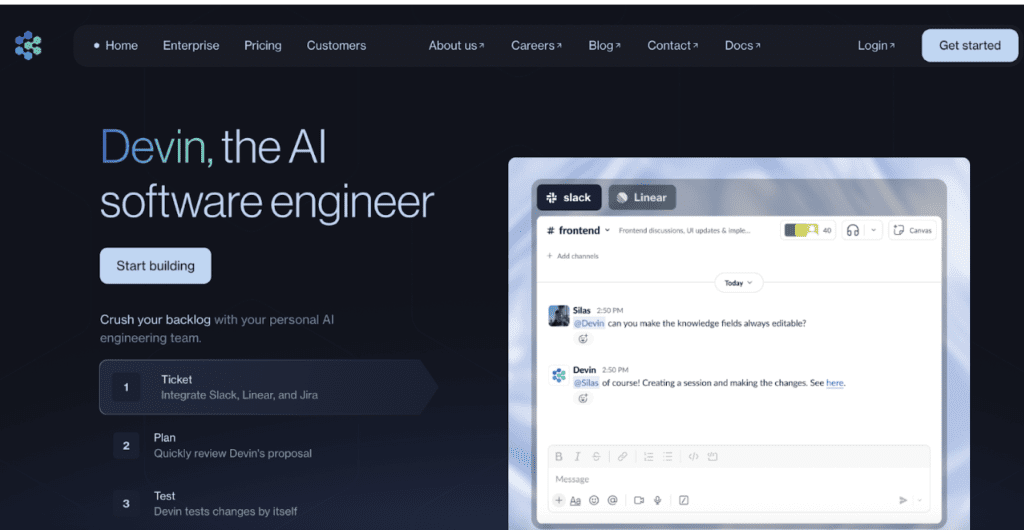
Devin (also known as OpenDevin) provides an “AI Engineer” experience, focusing on executing complex, multi-step tasks. Rather than merely generating code snippets, Devin manages larger coding workflows, effectively simulating a software engineer’s iterative process.
- What it generates:
Full-featured project scaffolding, including frontend and backend modules, and multi-stage task completion, such as adding new features, performing refactors, and generating comprehensive tests. - Outcome sweet spot:
Excels at Level 3 complexity, often used to develop frontend-backend integrated apps. Level 4 (full-stack CRUD apps) can be effectively supported with additional human oversight. Level 5 remains achievable but usually demands a clear human-in-the-loop to guide architecture decisions. - Code ownership/export:
Users maintain full ownership of generated code and can easily export and integrate it into existing workflows. - Strengths:
Strong task-planning capabilities; excels at iterative development; highly adaptable to changing project requirements. - Best for:
Development teams are experimenting with AI-driven engineering workflows, iterative prototyping, and comprehensive feature-building processes.
Flatlogic Generator
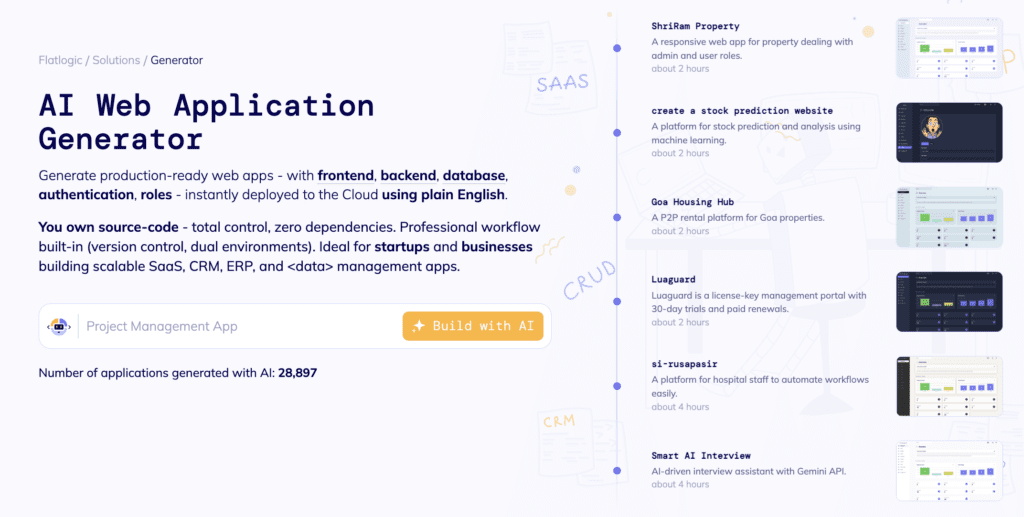
Flatlogic Generator uniquely combines AI-driven schema extraction with deterministic code generation, ensuring structured, clean, and predictable applications. It’s widely used for generating reliable production-grade applications suitable for enterprise environments.
- What it generates:
Complete frontend-backend applications with database integration, role-based authentication, permission management, and infrastructure setup, all neatly packaged for immediate use. - Outcome sweet spot:
Robustly covers Level 3 and reliably delivers Level 4 applications. Level 5 (advanced SaaS apps with multi-tenancy, payment systems, and detailed RBAC) can be comfortably achieved with Flatlogic’s built-in tools and guided extensions. - Code ownership/export:
Provides full and transparent ownership with easy codebase exports, Git integration, and excellent maintainability. - Strengths:
Enterprise-ready architecture; deterministic, stable outputs; excellent code structure; intuitive schema-first design. - Best for:
Businesses or startups needing reliable, structured, and maintainable full-stack web apps with clear scalability paths.
GPT-Pilot (open source)
GPT-Pilot is an open-source autonomous application builder, leveraging AI to generate project structures through user-defined goals and conversational guidance. It is designed for developers who prefer complete transparency and customization.
- What it generates:
Fully-formed application scaffolds including frontend UIs, backend APIs, databases, and interactive features built iteratively through AI assistance. - Outcome sweet spot:
Strong at delivering Level 3 (frontend + API integration). Level 4 is feasible with moderate manual refinements and developer input. Level 5 requires substantial guidance but is achievable for committed teams. - Code ownership/export:
Completely open-source; users have full ownership and control over the generated codebase, facilitating continuous evolution and customization. - Strengths:
Transparency, full control, community-driven improvements; ideal for customization and experimental projects. - Best for:
Teams or solo developers who value control, transparency, and the ability to tweak every aspect of their AI-assisted workflow.
Lovable
Lovable offers a smooth conversational AI interface that helps you build full-stack apps rapidly, strongly emphasizing rapid frontend and backend integration. It quickly creates web apps optimized for rapid prototyping and iterative product development.
- What it generates:
Complete web applications featuring interactive frontends, integrated backends, and basic CRUD functionality, typically ready to demonstrate and test quickly. - Outcome sweet spot:
Excellent at achieving Level 3 (frontend integrated with backend services like Supabase). Reaching Level 4 (full CRUD with authentication and custom logic) is achievable but may require additional refinement. Level 5 can be reached, but generally needs significant developer input for advanced SaaS requirements. - Code ownership/export:
Straightforward code ownership; full exportable repositories ready for custom development. - Strengths:
Intuitive conversational interface; excellent for fast-paced prototyping; streamlined integration with backend services. - Best for:
Rapid prototyping, startups validating product ideas, or teams needing high-speed development cycles.
Replit
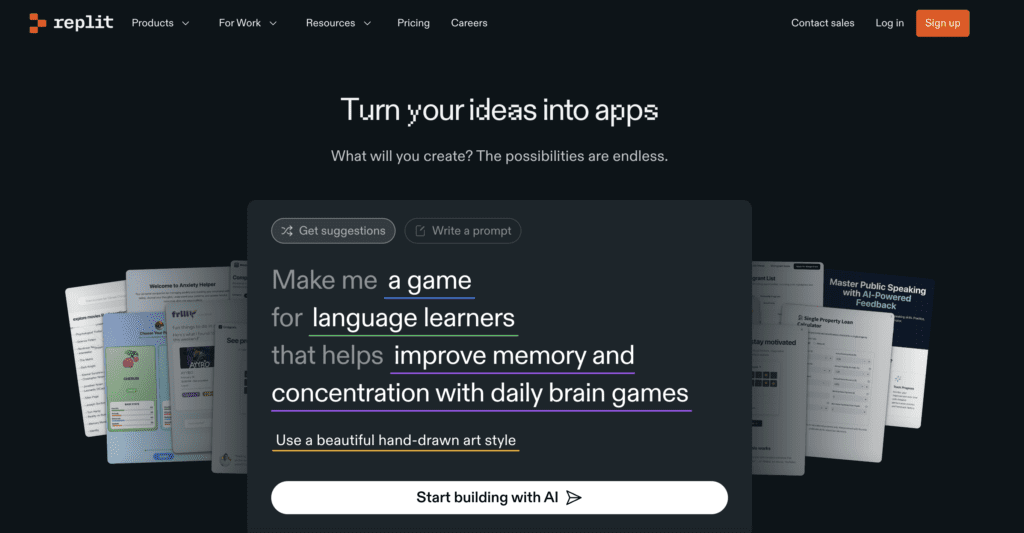
Replit provides a browser-based, end-to-end environment for developing and hosting applications, enhanced by AI-generated code. Users benefit from live editing and immediate deployment, supporting continuous iterations.
- What it generates:
Fully runnable web applications, APIs, interactive tools, and real-time collaboration features directly within the browser environment. - Outcome sweet spot:
Comfortably handles Level 2 (interactive frontend), consistently reaches Level 3 (integrated backend). Level 4 (custom CRUD systems) can be obtained through additional human-guided iterations. Level 5 complexity typically requires extensive manual oversight. - Code ownership/export:
Complete exportable code repositories, fully controlled by users and easily integrated into external development pipelines. - Strengths:
Great for live collaboration, instant deployment, and real-time feedback; ideal for iterative coding and prototyping. - Best for:
Education, hackathons, real-time collaborative development, and agile teams need immediate feedback.
Vercel v0
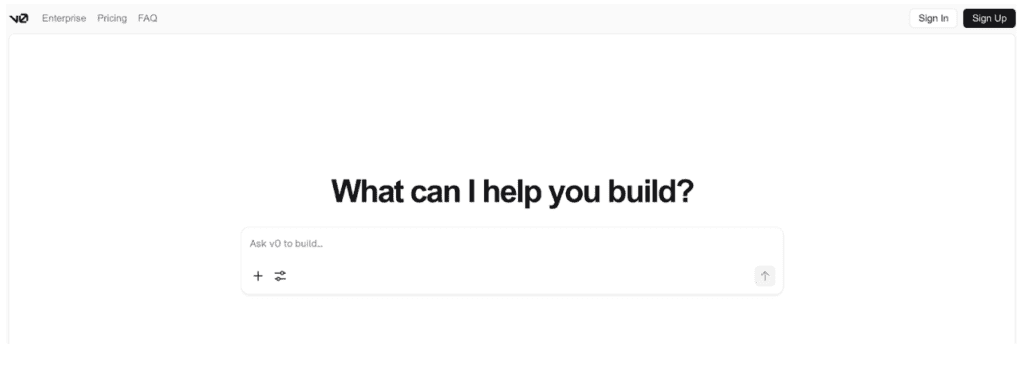
Vercel v0 rapidly generates polished frontend components and screens using AI, perfect for accelerating visual and UI-driven projects. It simplifies creating interactive, high-quality frontends in minimal time.
- What it generates:
High-quality frontend UI code, including responsive designs, interactive components, and flexible layouts, ready for integration with backends. - Outcome sweet spot:
Efficiently delivers Level 1 and Level 2 (interactive frontend) solutions. Level 3 is achievable when paired with backend integrations. Level 4 requires dedicated backend pairing; Level 5 typically needs substantial additional backend development. - Code ownership/export:
Full exportable code ownership, ready for backend integration. - Strengths:
High-quality UI; exceptional visual polish; rapid prototyping speed. - Best for:
Frontend-heavy projects, design-driven teams, or rapid UI prototyping before backend integration.
Comparison Table: Top 8+ AI-Powered App Generators of 2025
| Tool | What it Generates | Outcome Sweet Spot | Code Ownership/Export | Strengths | Best for |
| Bolt.new (by Vercel) | Full-stack web apps with frontend views, database, server routes | L3 reliably, L4 achievable, L5 with effort | Clean, fully exportable GitHub repositories | Speed, ease-of-use, seamless Vercel integration | Rapid MVP iterations, frontend teams |
| Create.xyz | Interactive web apps, responsive UIs, backend integration | Efficient L3, L4 achievable easily, L5 with adjustments | Fully exportable, customizable codebase | Rapid conversational app generation, easy collaboration | Quick prototypes, internal tools, startups |
| Devin / OpenDevin | Comprehensive scaffolding, frontend/backend modules, multi-step tasks | Solid L3, good L4 with oversight, L5 possible with human guidance | Full user ownership, easy exports | Advanced task planning, iterative AI-engineering | Teams exploring iterative AI-driven workflows |
| Flatlogic Generator | Production-ready full-stack apps, DB integration, RBAC, infrastructure setup | Robust L3–L4, comfortably achieves L5 with extensions | Full transparent ownership, exportable repos with Git integration | Enterprise-ready, deterministic structure, predictable code | Businesses/startups needing scalable, structured apps |
| GPT-Pilot (open source) | Complete apps with frontend UIs, backend APIs, and DB integrations | Strong at L3, moderate effort for L4, significant human guidance for L5 | Fully open-source, complete ownership | Transparency, customization, open development community | Developers valuing control, transparency, customization |
| Lovable | Rapid conversational full-stack apps, quick frontend-backend integration | Excellent at L3, achievable L4, L5 requires substantial effort | Straightforward code exports, full ownership | Fast conversational interface, quick prototyping | Rapid prototyping, idea validation, startups |
| Replit | Runnable web apps, real-time collaboration, APIs, browser-based IDE | Strong L2–L3, moderate human guidance for L4, significant effort for L5 | Fully exportable, easy external integration | Instant deployments, real-time collaboration, iterative prototyping | Education, collaborative teams, hackathons |
| Vercel v0 | Polished frontend components/screens, responsive, interactive UI | Excellent at L1–L2, good L3 paired with backend, L4–L5 needs backend integration | Complete frontend ownership, fully exportable | Visually polished UIs, rapid prototyping, and high-quality code | Frontend-heavy projects, design-driven prototypes |
Conclusion
In 2025, the era of AI-powered app generation has decisively moved from early experimentation to mainstream adoption, fundamentally reshaping how software gets built. Our extensive research shows that AI-driven tools have become the standard starting point for web applications, with 38% of developers now relying primarily on these platforms. Manual-only coding continues its decline, representing only 20.8% of development starts.
Today’s AI app generators are capable of much more than simple scaffolding; they empower teams to deliver sophisticated apps rapidly. Most users comfortably achieve at least frontend-backend integrations (Level 3) or even robust custom full-stack applications (Level 4). A notable and growing subset (14.5%) also successfully deploys complex, production-grade SaaS (Level 5), complete with advanced permissions, payments, and multi-tenancy.
However, certain challenges remain. Architectural context loss (45.5%), unclear pricing (41.9%), security concerns (35%), and limited customization (33.3%) still pose friction points. The good news: these issues are steadily diminishing as tools mature, with 11.2% of users now reporting no major obstacles.
To select the right AI-powered app generator, prioritize tools that:
- Clearly deliver the complexity level (L3, L4, or L5) your project demands.
- Provide full and transparent code ownership and straightforward export.
- Offer intuitive deployment pathways to popular hosting environments like AWS, Google Cloud, or Vercel.
This article’s detailed analysis and comparison equip you with the necessary insights to confidently navigate the rapidly evolving landscape of AI-assisted development.
Consider Flatlogic Generator – an AI-powered platform focused on generating structured, production-ready applications. It ensures clean code, straightforward maintainability, scalability, and full code ownership, making it particularly suitable for creating reliable full-stack web applications, internal tools, or SaaS products.